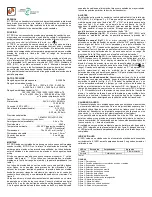
BTL5-A/C/E/G1_-M_ _ _ _-B/Z-NEX-S32/KA_ _
Micropulse Linear Transducer - Rod Style
3
english
Ignition Class "n"
2.1
Characteristics
Micropulse transducers feature:
–
Very high resolution, repeatability
and linearity
–
Immunity to shock, vibration,
contamination and electrical noise
–
An absolute output signal
–
Automatic signal regulation
–
100 % adjusting range
–
Removable calibration device
–
2 kHz update rate
–
Error information via output signal
–
Pressure rated to 600 bar
–
IP 67 per IEC 60529
2.2
Function
The transducer contains a wave-
guide enclosed by an outer stain-
less steel rod. A magnet attached to
the moving member of the machine
or to the cylinder piston is moved
over the rod and its position con-
stantly updated.
The magnet defines the measured
position on the waveguide. An inter-
nally generated INIT pulse interacts
with the magnetic field of the mag-
net to generate a magnetostrictive
torsional wave in the waveguide
which propagates at ultrasonic
speed.
The torsional wave arriving at the
end of the waveguide is absorbed in
the damping zone. The wave arriv-
ing at the beginning of the wave-
guide creates an electrical signal in
the coil surrounding the waveguide.
The propagation time of the wave is
used to derive the position. Depend-
ing on the version the corresponding
value is output as a voltage or a cur-
rent either with rising or falling char-
acteristic. This process takes place
with measuring high precision and
repeatability within the stroke range
defined as nominal stroke length.
At the rod end is a damping zone,
within which no reliable signal is
available, but which may be entered
by the magnet.
The electrical connection between
the transducer, the processor/con-
troller and the power supply is via a
cable, which depending on the ver-
sion is either fixed or connected
using a female connector.
2
Function and Characteristics
Dimensions for installing the
Micropulse transducer:
➥
➥
➥
➥
➥
Fig. 3-2
Dimensions for installing the mag-
net:
➥
➥
➥
➥
➥
Fig. 3-4
2.3
Available stroke lengths
and magnets
To ensure flexible application, nomi-
nal transducer stroke lengths of
from 25 to 4000 mm and various
types of magnets are available.
Magnets therefore need to be or-
dered separately.
3
Installation
3.1
Mounting
When possible, use non-magnetiz-
able material for attaching the trans-
ducer and magnet ring.
➥
➥
➥
➥
➥
Fig. 3-1.
When attaching the transducer to
magnetizable materials, appro-
priate measures must be taken to
protect against magnetic disturb-
ances
➥
➥
➥
➥
➥
Fig. 3-1. Note the
recommended distance of the
transducer and cylinder from
strong, external magnetic fields.
Fig. 3-1: Mounting
➀
-
➂
for magnetizable materials
➃
for non-magnetizable materials
a = Spacer made of non-mag-
netizable materials
b = Magnet
non-magnetizable material
















































